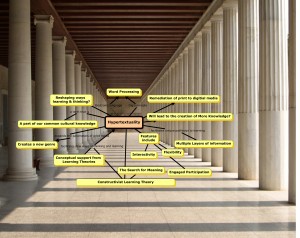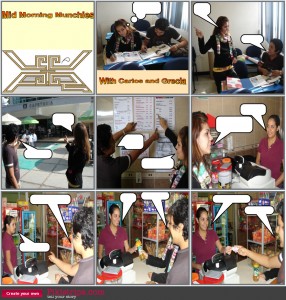Hypertextuality in Cyberspace: A new genre and a new way of learning?
Commentary #3 [pp 26 -28 Bolter text: ETEC 540]
The use of technology for communication, the digital “word processor” and in particular the advent of the use of “hypertext” within electronic media has fundamentally altered communication, the ways we use language and twenty-first century e-learning environments. Digital modes of communication and potentially hypertextuality itself may result in the creation of more knowledge (Heim, 1987) and reshape or reconfigure our ways of thinking in positive and creative ways (Kamin, 1984). In his book, “Writing Space: Computers, Hypertext & the Remediation of Print” Bolter asserts that hypertext enables a specific type of remediation [a process involving the transition from one media to another] that allows for the emergence of a distinctive and new genre. A review of what is meant by the term “hypertext” as Bolter uses it will begin this discussion followed by an overview of three important features that distinguish it from its predecessor [print media] including it’s immediacy, flexibility and interactivity (Bolter, 2001). Finally, a specific type of learning that is uniquely enhanced by hypertext will be examined through the lens of its conceptual or theoretical support in constructivist learning theory (Mahoney, 2003).
To begin, the term “hypertextuality” is no longer “…esoteric…” but is understood by most people within every day speech, and is indeed now, at the beginning of the twenty first century, a term that is a part of our “…common cultural knowledge” (Bolter, pp27). Hypertext as defined by Bolter means “…a network of interconnected writings…” of pages of information that “…may be of equal importance in the whole text…”(Ibid, pp 27). It is more than the electronic equivalent to footnotes in a book, because as indicated above, the information that is provided may be fundamental to understanding the main body of the text (Ibid, 2001).
Bolter refines his definition of hypertext to include some broad characteristics, including such things its immediacy; versus for example a footnote in a printed book, cited from a specific printed resource. In the book format, following up on a footnote, can be a very time consuming and labour intensive activity.
Two other major components of hypertext include its flexibility and interactivity, features that according to Bolter help to transform electronic writing into a new mode and genre, that of hypertextuality (Ibid 2001). The flexibility of the use of hypertext operates on a number of levels, helping it to serve both informational and rhetorical purposes. Hypertext links can clarify meaning [contextualized to a specific use] and lead the reader back to the text or it can prompt the reader to explore entirely different sites or nodes of information related to the topic. Hypertext also encourages different types of learning styles involved in knowledge acquisition and according to some psychological literature, to ways of thinking and of cognition also (Mahoney, 2003).
Bolter asserts that hyper textual links are associative in terms of their impact on knowledge acquisition. Constructivism is just one of the major learning theories that provides conceptual and theoretical support for Bolter’s argument that hypertext is not only a different genre but supports also a different way of learning and acquiring knowledge and information. Hypertextual learning is facilitated in keeping with Constructivist notions around the importance of the search for Meaning as both an impetus for and outcome of, the process of Learning.
Within this larger theory, the principles of Engaged Participation, encouraged by the structure of hypertext itself is further promoted by facilitating unique virtual and conceptual links between the material and the reader/learner. In tandem with this feature of interactivity, hypertext also encourages synchronous movements and unique learning pathways through the virtual ‘text’.
An analysis of the process of reading and learning involved in the use of hypertext, quickly reveals that like psychology, not only are there many theories of learning, no one learning theory fits every use or application of hypertext (Jonassen 2003). Moreover, and drawing on this same parallel example, what is best for the learner [or patient] may be a combination of learning paths rather than a unity, a requirement that hypertext readily facilitates.

Hypertext and Learning: as The Search For Meaning
One of the many layers of the complexity of hypertext in terms of its functionality in e-learning contexts is its ability, from a Constructivist perspective, to provide the learner with Meaning, which is as noted above, the primary impetus for learning in this view. Hypertext provides a web of meanings, a configuration that is constructed uniquely and actively by each student, driven by their own needs and particular learning objectives and styles.
Complementary to the use of the hypertextuality in constructing meaning is its enhancement of interactivity as students engage with the layers of information provided within in a specific topic area. A self created trajectory through the electronic text enables the individual to effectively embed content more firmly within their own pre-existing schemas or world view, resulting in more comprehensive assimilation of information, better retention or memory of key concepts, and greater practical application of the new knowledge or skill (Sutherland 2001).
The notion of conceptual coherence is also inherently woven into and throughout hyper textual materials and allows innovations and improvements to learning materials by providing flexibility to the instructor or curriculum designer, in terms of its format, structure, and choice of pedagogical methodologies (Sutherland 2001).
A critical feature of hypertextuality is that it can provide a conceptual framework, not only for the design of virtual curricular elements but also in supporting a cognitive substructure from which key concepts and learning objectives can be constructed. Importantly, hypertextuality as a learning tool, also demonstrates an effective translation of learning theory into practice, by facilitating and encouraging students to arrive at the same learning objective via their own unique cognitive or conceptual pathway.
To sum up, key elements of hypertext including its immediacy, flexibility and interactivity extend the reach of the both the type and the scope of the information provided. Bolter provides an effective argument [only briefly touched upon here] to support his contention that hypertextuality provides not only a remediation from print to digital media but that it also expands the parameters of the medium itself sufficiently to be considered a new genre. Finally, in an e-learning context, hypertextuality also enables new ways of reading, thinking and of learning, which are given conceptual support by Constructivist learning theory.
Digital Image:
Created using CMap Technology
References
Bates, A.W., Poole, G. (2003) Effective Teaching with Technology in Higher Education
Jossey-Bass, San Francisco, USA
Bolter, J.D. (2001) Writing Space: Computers, Hypertext and the Remediation of Print
2nd Edition, Lawrence Erlbaum Associates, Inc., Publishers
Carvin, A. (1998) Constructivism Basics
Ed Web: Exploring Technology and School Reform
http://www.ibiblio.org/edweb/constructivism.basics.html
ETEC 540: Module 4 (November 2009) Hypertext
Masters in Educational Technology, online course material, UBC
Jonassen, D. (2003) The Vain Quest for a Unified Theory of Learning
American Journal of Distance Education
Heim (1987) cited in ETEC 540 Module 4: Idea Processors & the Birth of Hypertext
Retrieved online from Readings, 4Nov2009
Kamin, J. (1984). The Think Tank Book. Berkeley, CA: Sybex.
Retrieved online from Readings, ETEC 540 Mod 4Nov2009
Mahoney, M.J. (2003) What is Constructivism and Why Is It Growing?
Presented at the 8th International Congress of Constructivism and Psychotherapy, Italy, June 2003
The Society for Constructivism in the Social Sciences; website
http://www.constructivism123.com/
Postman, N. (1992) Technopoly: The Surrender of Culture to Technology
Vintage Books, New York, NY
Sutherland,P. (2001) A Lifelong Learning Journey; Utilizing Piaget’s and Biggs’ theories of development
Education Line Article, University of Sterling, Scotland
http://www.leeds.ac.uk/educol/documents/00002580.htm
Thomas, M. (2002) Gestalt Learning Theory for Dummies
Minot State University
http://www.misu.nodak.edu/psych/Burke/book/gestalt.htm



